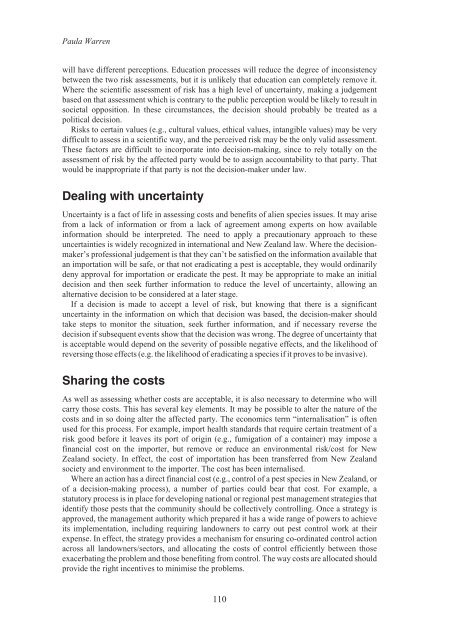Alien Species.vp - IUCN
Alien Species.vp - IUCN
Alien Species.vp - IUCN
Create successful ePaper yourself
Turn your PDF publications into a flip-book with our unique Google optimized e-Paper software.
Paula Warren<br />
will have different perceptions. Education processes will reduce the degree of inconsistency<br />
between the two risk assessments, but it is unlikely that education can completely remove it.<br />
Where the scientific assessment of risk has a high level of uncertainty, making a judgement<br />
based on that assessment which is contrary to the public perception would be likely to result in<br />
societal opposition. In these circumstances, the decision should probably be treated as a<br />
political decision.<br />
Risks to certain values (e.g., cultural values, ethical values, intangible values) may be very<br />
difficult to assess in a scientific way, and the perceived risk may be the only valid assessment.<br />
These factors are difficult to incorporate into decision-making, since to rely totally on the<br />
assessment of risk by the affected party would be to assign accountability to that party. That<br />
would be inappropriate if that party is not the decision-maker under law.<br />
Dealing with uncertainty<br />
Uncertainty is a fact of life in assessing costs and benefits of alien species issues. It may arise<br />
from a lack of information or from a lack of agreement among experts on how available<br />
information should be interpreted. The need to apply a precautionary approach to these<br />
uncertainties is widely recognized in international and New Zealand law. Where the decisionmaker’s<br />
professional judgement is that they can’t be satisfied on the information available that<br />
an importation will be safe, or that not eradicating a pest is acceptable, they would ordinarily<br />
deny approval for importation or eradicate the pest. It may be appropriate to make an initial<br />
decision and then seek further information to reduce the level of uncertainty, allowing an<br />
alternative decision to be considered at a later stage.<br />
If a decision is made to accept a level of risk, but knowing that there is a significant<br />
uncertainty in the information on which that decision was based, the decision-maker should<br />
take steps to monitor the situation, seek further information, and if necessary reverse the<br />
decision if subsequent events show that the decision was wrong. The degree of uncertainty that<br />
is acceptable would depend on the severity of possible negative effects, and the likelihood of<br />
reversing those effects (e.g. the likelihood of eradicating a species if it proves to be invasive).<br />
Sharing the costs<br />
As well as assessing whether costs are acceptable, it is also necessary to determine who will<br />
carry those costs. This has several key elements. It may be possible to alter the nature of the<br />
costs and in so doing alter the affected party. The economics term “internalisation” is often<br />
used for this process. For example, import health standards that require certain treatment of a<br />
risk good before it leaves its port of origin (e.g., fumigation of a container) may impose a<br />
financial cost on the importer, but remove or reduce an environmental risk/cost for New<br />
Zealand society. In effect, the cost of importation has been transferred from New Zealand<br />
society and environment to the importer. The cost has been internalised.<br />
Where an action has a direct financial cost (e.g., control of a pest species in New Zealand, or<br />
of a decision-making process), a number of parties could bear that cost. For example, a<br />
statutory process is in place for developing national or regional pest management strategies that<br />
identify those pests that the community should be collectively controlling. Once a strategy is<br />
approved, the management authority which prepared it has a wide range of powers to achieve<br />
its implementation, including requiring landowners to carry out pest control work at their<br />
expense. In effect, the strategy provides a mechanism for ensuring co-ordinated control action<br />
across all landowners/sectors, and allocating the costs of control efficiently between those<br />
exacerbating the problem and those benefiting from control. The way costs are allocated should<br />
provide the right incentives to minimise the problems.<br />
110












